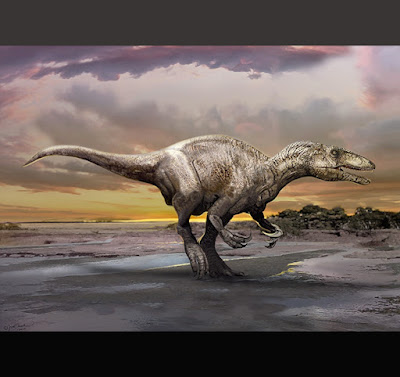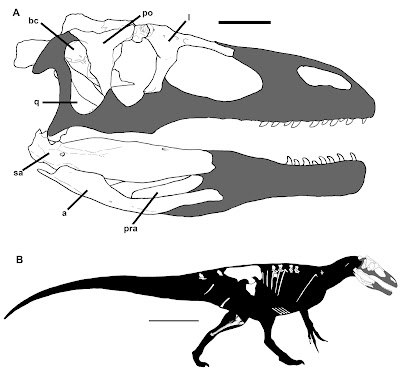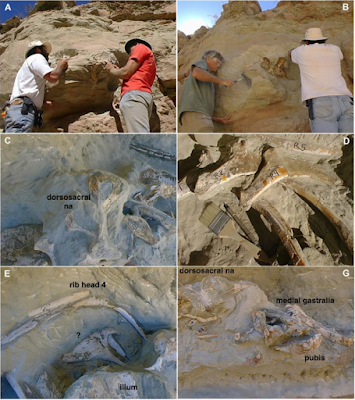|
|
| Пишет Species New to Science ( @ 2016-07-21 10:44:00 |
|
|
|
|
|
|
|
|
|
|
|
|
|
|
[Paleontology • 2016] Murusraptor barrosaensis • A New Megaraptoran Dinosaur (Theropoda, Megaraptoridae) from the Late Cretaceous of Patagonia
 |
| Murusraptor barrosaensis Coria & Currie, 2016 |
Abstract
A skeleton discovered in the Upper Cretaceous Sierra Barrosa Formation (Turonian-Coniacian) of Neuquén Province, Argentina represents a new species of theropod dinosaur related to the long snouted, highly pneumatized Megaraptoridae. The holotype specimen of Murusraptor barrosaensis n.gen et n.sp. (MCF-PVPH-411) includes much of the skull, axial skeleton, pelvis and tibia. Murusraptor is unique in having several diagnostic features that include anterodorsal process of lacrimal longer than height of preorbital process, and a thick, shelf-like thickening on the lateral surface of surangular ventral to the groove between the anterior surangular foramen and the insert for the uppermost intramandibular process of the dentary. Other characteristic features of Murusraptor barrosaensis n.gen. et n. sp.include a large mandibular fenestra, distal ends of caudal neural spines laterally thickened into lateral knob-like processes, short ischia distally flattened and slightly expanded dorsoventrally. Murusraptor belongs to a Patagonian radiation of megaraptorids together with Aerosteon, Megaraptor and Orkoraptor. In spite being immature, it is a larger but more gracile animal than existing specimens of Megaraptor, and is comparable in size with Aerosteon and Orkoraptor. The controversial phylogeny of the Megaraptoridae as members of the Allosauroidea or a clade of Coelurosauria is considered analyzing two alternative data sets.
Systematic Paleontology
Dinosauria Owen, 1842
Theropoda Marsh, 1881
Tetanurae Gauthier, 1986
Megaraptora Benson, Carrano, Brusatte, 2010
Megaraptoridae Novas, Agnolin, Ezcurra, Porfiri, Canale 2013
Murusraptor barrosaensis new genus, new species
Etymology: “Murus” is a Latin term for “wall”, referring to the discovery of the specimen in the wall of a canyon; “barrosaensis” alludes to Sierra Barrosa, the locality where it was collected.
Holotype: Partial skeleton (Museo Carmen Funes MCF-PVPH-411) includes a complete braincase, lacrimal, prefrontal, postorbital, quadrate, pterygoid, ectopterygoid, teeth, twelve vertebrae, eleven thoracic ribs, one haemal arch, several gastralia, a manual ungual, complete left ilium, part of right ilium, proximal ends of the pubes, distal ends of the ischia, the right tibia, and a calcaneum (Fig 1).
 |
| Fig 1. A) Skull reconstruction of Murusraptor barrosaensis, MCF-PVPH-411. B) Body reconstruction Both illustrations show recovered elements in white. Scale bars: A = 10 cm, B = 1 m. DOI: 10.1371/journal.pone.0157973 |
Diagnosis: Murusraptor barrosaensis is unique in having anterodorsal process of lacrimal longer than height of preorbital process, and a thick, shelf-like thickening on the lateral surface of surangular ventral to the groove between the anterior surangular foramen and the insert for the uppermost intramandibular process of the dentary. Two other characters are only known in Murusraptor; sacral ribs hollow and tubelike; short ischia distally flattened and slightly expanded dorsoventrally. These characters are equivocal because they are unknown in other members of the clade. Also, the following combination of diagnostic characters was obtained after running the phylogenetic analysis using TNT: Character 95, basipterygoid processes of the basisphenoid located anteroventrally, with basisphenoid recess opening posterodorsally (also present in coelophysids); Character 98, basisphenoid with a shallow embayment indentation between basal tubera and basipterygoid processes (also present in Cryolophosaurus and basal theropods); Character 216, rather straight chevrons (reversal to the plesiomorphic condition).
Rodolfo A. Coria and Philip J. Currie. 2016. A New Megaraptoran Dinosaur (Dinosauria, Theropoda, Megaraptoridae) from the Late Cretaceous of Patagonia. PLoS ONE. 11(7): e0157973. DOI: 10.1371/journal.pone.0157973
Another Brick in the “Murus”: Meet the newest Megaraptoran theropod, Murusraptor http://blogs.plos.org/paleocomm/2016/07/2

